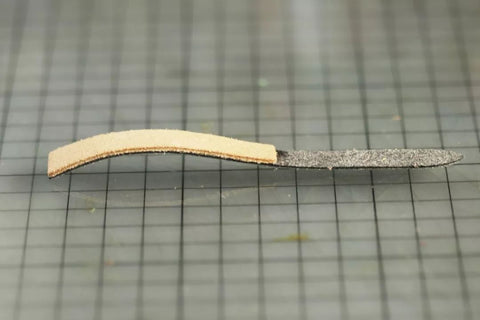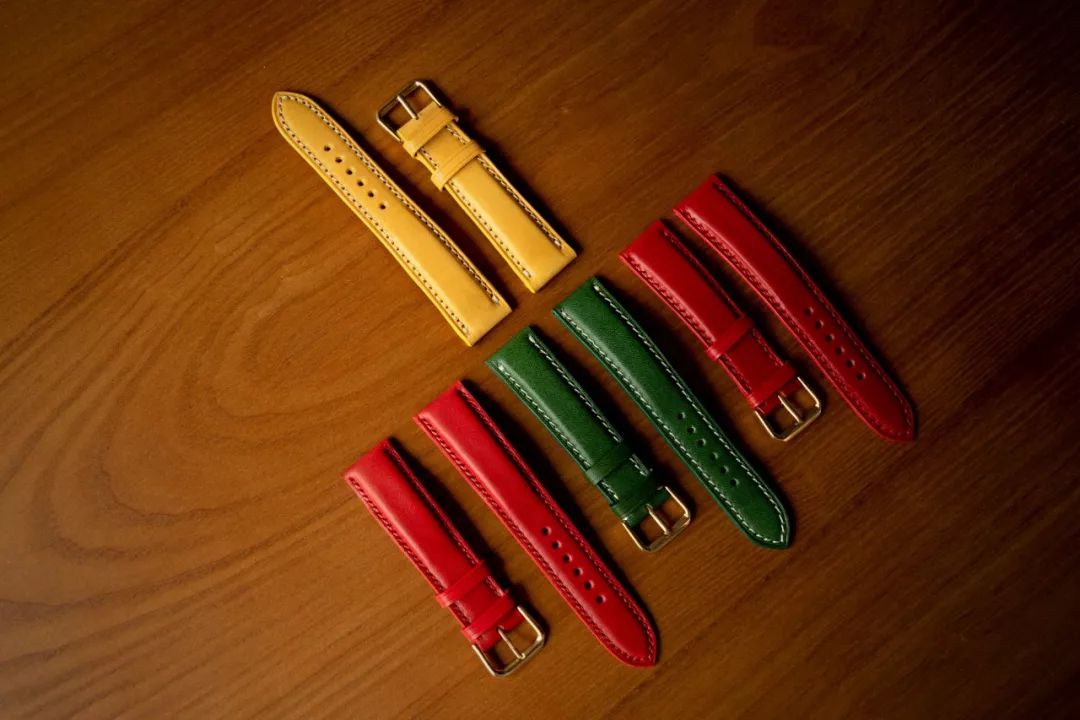Handmade vegetable tanned leather straps

What are the criteria for a good strap?
It is just the right margin, and the fine chopping distance is matched with delicate stitches...
Is a well-handled edge, enough to meet the most demanding Virgo requirements...
It is the smooth appearance lines and integrity, which bring people a bright visual enjoyment...
After being exposed to the wind and the sun day after day, it still gives people a skin-friendly touch...

As a representative of exquisite leather accessories, straps have always been the benchmark for testing material selection and craftsmanship.
So today we will talk about the strap making in detail.
Material Selection | Strap
Handmade leather goods are inseparable from leather.
When choosing a leather strap, you often need to consider: comfort, water resistance, durability, and the most important thing is the choice of material for the strap from the inside out.
The inner core of industrial watch straps usually uses a foam layer. Although it brings a soft feel, it also causes odor due to the absorption of sweat and bacteria after a long period of use.
When making the strap by hand, we use a two-layer vegetable tanned leather inner core with microfiber, both of which are breathable, which can prevent excessive swelling and odor inside the strap.

The choice of outer skin/bottom leather also tends to choose waterproof, breathable, and comfortable materials, such as Zermatt and Barenia, which are commonly used to make straps, are well-known Hermès watch strap royal skins and bottom skins.
Others that can be used as dough include horse hip leather, horse bridle leather, crocodile leather, French sheep and so on.

At the same time, due to long-term use, the watch strap is prone to stretch deformation or breakage. Therefore, no matter what kind of leather strap it is, it is best to add a layer of reinforcement between the top skin and the bottom skin. The commonly used material is spunlace cloth with a general thickness of 0.3mm. We use TYLAN spunlace cloth imported from Italy.

Craftsmanship | Straps
After the material is determined, the factors that determine the success or failure of the watch strap include the processing of the material and the production skills, just like a top chef needs to accurately grasp the attributes of each ingredient and control the heat of each step with ease.
1.material handling
Leather thickness: The normal range of leather for making watch straps is 0.8mm-1.2mm, depending on the actual situation. For example, when we use French bull leather as the dough, we will thin the leather to 0.8mm. The bottom leather is made of soft and skin-friendly special leather, usually thinned to 0.8mm.
3 layers of strap ring: 1.0mm thickness in total, 0.3mm spunlace cloth in the middle, 0.4mm and 0.3mm for the surface and bottom skin respectively.
Bezel specifications: 16mm straps are suitable for bezel widths of 4.8mm, and 5.0-5.2mm wide bezels for straps above 16mm.
Drum strap inner core: The drum core material is composed of three layers, which are the second layer of vegetable tanned leather, 1.0mm superfiber, and 0.3mm spunlace cloth.


2.process flow
Fabrication of the inner core of the drum: the lamination of the drum leather and the microfiber, pay attention to the bending of the drum when laminating. You can use the bend stick tool, if you don’t have one, you can also select objects with a suitable curvature such as hammers, containers, etc.

Drum pad core rounding: Through multiple cutting and trimming, the inner core becomes an excessively natural arc drum. And use sandpaper to smooth the surface. When trimming, double-sided adhesive can be used to fix the inner core on the glass plate.
Adhesion of the pad core to the spunlace cloth: use the positioning grid to mark the paste position of the pad core on the spunlace cloth. Apply glue evenly.
Bonding of the skin and the inner core: Use a beef bone knife to shape to achieve a drumming effect, and pay attention to the shape of the bend. After the shaping and fitting are completed, the skin is trimmed according to the edge of the spunlace cloth.
Skin correction: Correct the excess size of the skin according to the spunlace cloth.
Handle the lug end and pin buckle end of the dough: mark the folding position of the dough and the position of the skin and the bottom skin. When folding, place a plastic rod of about 1.8-2.0mm at the joint of the lugs and the installation position of the pin buckle. The skin is cut from the surface to create a natural and gentle slope, and the thinner the end, the better. In the same way, the bottom skin is thinned out from the surface to create a natural slope.
Bottom and skin pasting: After the above operation is completed, paste according to the marked position, and correct the bottom skin.
Edge treatment: usually because the corrected edge is relatively smooth, you can directly draw the edge...or use primer to level the leather edge and then press the line. Choose the 1.5mm specification for the crimping device.


Oil edge: This step is mainly the oil edge of the lug connection position, pin buckle and meson position. In the video, we first oil the edges 1-2 times before chopping. But in fact, other parts can also be cut and stitched before oiling. The active meson should be oiled after the watchband circle is made, so that the edge looks like a whole.

Stitching holes for straps: It is recommended that the pinholes of straps be round punched or row punched with a specification of 1.8mm. The choice of chopping distance is 2.7 or 3.0, depending on the strap specification. 16mm and 18mm straps use 2.7mm chopping distance, and 20mm and above use 3.0mm chopping distance. With a 0.35mm diameter wire. Use an awl to punch the first hole in the middle of the tail end of the long tape, and then punch holes from the tail end to both sides.
Oil edge after suture: Correct the edge protruding caused by cutting the suture. Wet grinding can be used to avoid edge oil debris falling into the suture hole. For a final coat of oiled edges, the edge oil can be diluted and applied thinly to achieve a natural finish on the edge without adding thickness.
Install the pin buckle and dial and you are done.

Finally, it is worth mentioning that no matter how finely crafted the watch strap is, and no matter how waterproof and dirt-resistant the material is, we recommend that the leather strap should be replaced after about half a year of use.
I believe that this is not a difficult task for other friends who have mastered the production technology and can easily obtain various strap production materials. It is easy to make ten or eight at a time.
We have also fully considered the needs of our friends, whether it is the sale of material packages, paper grids, individual skins/bottom skins, reinforcing cloth, etc., we have covered everything.


